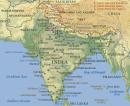Airlines Gather as India Opens Up
 Last week saw Britain and India agree to more than double air flights on existing routes between the two nations and open up lucrative new services to Indian cities. A similar deal was signed between India and the US. In the same week Jet Airways, India’s largest domestic carrier, announced that it will lift passenger traffic by 15-18 percent this year. So are we really about to see the much predicted boom in Indian air travel? Breaking Travel News investigates.The British and Indian governments had reopened bilateral air service talks on Tuesday last week following lobbying of both governments by numerous airlines including British Airways, Virgin, bmi and Air India. They were all keen to ease restrictions on air travel between the two countries, which offer potential sources of new revenue on routes where demand often outstrips existing service.
Last week saw Britain and India agree to more than double air flights on existing routes between the two nations and open up lucrative new services to Indian cities. A similar deal was signed between India and the US. In the same week Jet Airways, India’s largest domestic carrier, announced that it will lift passenger traffic by 15-18 percent this year. So are we really about to see the much predicted boom in Indian air travel? Breaking Travel News investigates.The British and Indian governments had reopened bilateral air service talks on Tuesday last week following lobbying of both governments by numerous airlines including British Airways, Virgin, bmi and Air India. They were all keen to ease restrictions on air travel between the two countries, which offer potential sources of new revenue on routes where demand often outstrips existing service.
“We are negotiating to increase the number of services between the two countries,” a UK Department of Transport spokesman had said, though the eventual deal stopped short of offering “open skies” or totally removing restrictions. The UK government wanted to liberalize travel between the two countries as much as possible, whilst the Indian government was more reserved. That said most of the interested carriers seem pleased with the results.
“It is excellent news for consumers and the aviation industry and shows the move towards liberalization is unstoppable and global,” a BA spokeswoman said. British airlines can now only offer 40 flights a week to India but his will rise in stages to 56 weekly flights to Mumbai and New Delhi by late 2006.
Virgin chief Richard Branson also welcomed the news. “As a result of these talks, passengers travelling between the UK and India will benefit from the increased competition which will ultimately lead to better value for money and quality of service for passengers travelling on these routes.” Virgin have been talking for some time about making a significant investment in an Indian airline.
Nigel Turner, chief executive officer of bmi, went further by identifying some of the elements that will fuel the future growth. “The potential market in India is enormous with more businesses looking to invest and more tourists wanting to travel to the region. The demand is there and we want to be able to offer our award winning product to as much of this growing market as possible.”
ADVERTISEMENT
So it’s all good news for the British carriers, but what of the domestic scene? Jet Airways is planning to spend USD$400 million buying and leasing Boeing planes so they must also see growth potential, even with the development of further domestic competition from Air Sahara and Air Deccan as well as planned new airlines Kingfisher and Spicejet.
“We just finished an excellent traffic year when we generated almost a million passengers or more,” Chief Operating Officer of Jet, Peter Luethi told reporters last week. “Traffic in the domestic market for this coming year is about 15 to 18 percent growth.”
If Asia’s fourth-largest economy is poised to grow significantly over the next five years then even the most conservative analysts predict massive growth in India’s air travel market. India has more than 1 billion people and a rapidly growing middle class. With an increased domestic wealth come new domestic passengers, both in the leisure and business markets. Meanwhile India’s tourism industry continues to flourish.
In a speech last week, United Airlines Chief Executive Glenn Tilton predicted that the “phenomenal” economic growth in China and India will continue. “As the middle class continues to grow, disposable income and the natural desire to travel will increase,” he said. “Travel originating in Asia is the fastest growing segment in the travel and tourism industry.” Meanwhile Boeing has forecast that India will be the fastest-growing aircraft market after China.
India, and the wider Asian air travel market represent an opportunity that most airlines are grasping with both hands. Competition will be intense, with new domestic airlines pitching in. Success or failure in these markets is clearly going to play a pivotal role on the future of the airline industry.
——-

